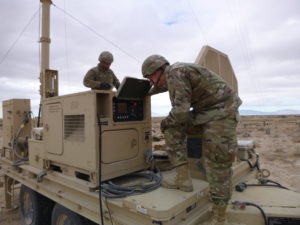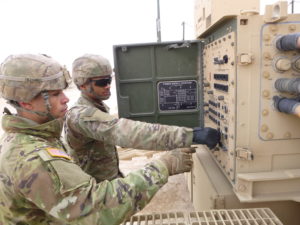By Mr. John Kimball & Mr. Robert Yelder, Air and Missile Defense Test Directorate, U.S. Army Operational Test Command
WHITE SANDS MISSILE RANGE, New Mexico – Air Defense Artillery Soldiers from Fort Bliss, Texas here are testing a new equipment system linking sensors with shooters across the battlefield.
Soldiers of the 3rd Battalion, 43rd Air Defense Artillery Regiment are working with the Bliss-based Air and Missile Defense Test Directorate of the Fort Hood, Texas-based U.S. Army Operational Test Command on the Army Integrated Air and Missile Defense System, collecting data from the system and Soldier operators to render a report to senior Army leaders on how the system functions in a realistic operational environment.
“The AIAMD will change the way Air and Missile Defense (AMD) formations fight,” said Col. William Dowling, AMDTD Director. “This system is crucial to AMD modernization and a significant step in getting the right equipment into the hands of the Soldiers.”
AIAMD’s sensors integrate weapons and a common mission command capability across an integrated fire control network to provide a high-fidelity Single Integrated Air Picture (SIAP) for the Army’s contribution to Joint IAMD capabilities, according to Maj. Peter Lawall, AMDTD Test Division Chief.
“The Integrated Battle Command System (IBCS), which is a key component of the AIAMD strategy,” he continued, “provides improved digital command and control capabilities, vastly expanding a battlefield commander’s ability to plan for current and future operations.”
The IOT&E is being conducted in several stages.
Software intensive Modeling and Simulation (M&S) air battles are used to stress the system, Live Air using multiple surrogate air threats, and Missile Flight Tests using real missiles and targets all take place.
Data from those events is recorded and Soldier responses and reactions are documented to generate a complete report on how the system functions in a realistic operational environment.
“The AIAMD IOT&E was an extremely complex test to conduct and was successful because of the collaborative effort put forth by all Stakeholders,” Lawall said.
Advancements in adversary air and missile threats necessitate the modernization of U.S. Air Defense Forces, according to Lawall.
Spec. Diane Choi, one Patriot Fire Control Enhanced Operator/Maintainer with the Patriot Battalion’s Battery B, said, “It’s worth it, as adversaries upgrade threat weapon systems, the need to modernize grows.”
Feedback provided by the Soldiers informed evaluators and capability developers of the actual capabilities and limitations of the AIAMD.
Following IOT&E, the next milestones are a declaration of Initial Operational Capability (IOC), followed by a Full Rate Production decision by the end of the year.
~~
About the U.S. Army Operational Test Command (USAOTC):
As the Army’s only independent operational tester, USAOTC tests Army, joint, multi-service, and multi-domain warfighting systems in realistic operational environments; using skilled Soldiers to provide data on whether the systems are effective, suitable, and survivable. USAOTC is required by public law to test major systems before they are fielded to its ultimate customer — the American Soldier
About the Air and Missile Defense Test Directorate (AMDTD):
AMDTD plans and conducts independent operational testing of air and missile defense related programs. Functions as OTC forward integration element at Fort Bliss, TX for Army, and Joint modernization efforts. A team centric organization focused on planning and executing credible Air & Missile Defense Operational Tests. AMDTD executes test missions with professionalism, honesty and integrity (truth) to ensure our customers attain the best capability to outpace any threat.


